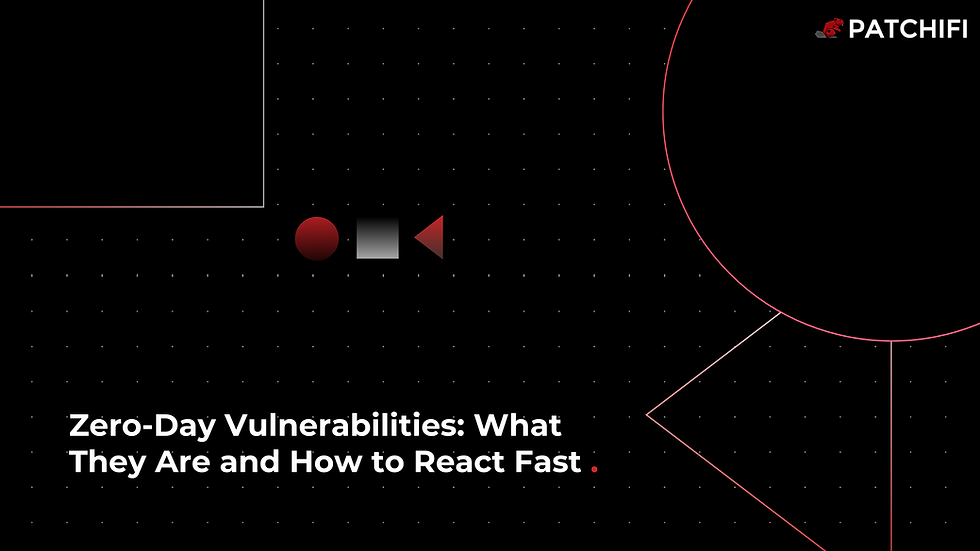Zero-Day Vulnerabilities: What They Are and How to React Fast
- Saarah J
- Aug 12
- 3 min read

In the world of cybersecurity, there are few terms more urgent or more misunderstood than zero-day vulnerabilities. When a zero-day surfaces, every minute counts. Yet most organizations are still asking the wrong question: “Are we exposed?” when they should be asking, “How fast can we patch?”
In this post, we’ll break down what zero-days are, why they’re dangerous, and most importantly how you can respond quickly and effectively using tools like Patchifi.
What Is a Zero-Day Vulnerability?
A zero-day vulnerability is a flaw in software or hardware that is discovered and exploited before the vendor has released a fix meaning defenders have “zero days” to protect against the threat.
These are high-value weapons for cybercriminals, nation-state actors, and ransomware gangs because:
• There’s no known patch.
• Security tools often can’t detect the exploit yet.
• Exploits are often sold on the dark web or used in targeted attacks.
In short: You don’t know about it until it’s already being used against you.
⚠️ Why Zero-Days Are So Dangerous
• No patch available (initially): Even the best security hygiene doesn’t prevent exploitation at first.
• Low detection rate: Since the vulnerability is unknown, traditional antivirus or EDR might miss it.
• Speed of exploitation: Once the vulnerability becomes public, attackers often weaponize it within hours.
• Targets widely used systems: Most zero-days are found in software with massive user bases like Microsoft Windows, Office, or browsers like Chrome.
According to Mandiant, nearly one-third of all zero-days exploited in 2023 targeted Microsoft technologies.
Zero-Day vs. N-Day Vulnerability
Once a vendor releases a patch, the zero-day becomes an N-day vulnerability — which is still dangerous, especially if organizations delay patching.
Many attackers shift to exploiting N-days because they know most systems remain unpatched for weeks.
Real-World Example: The 2021 Exchange Server Zero-Days
In March 2021, Microsoft disclosed multiple zero-day vulnerabilities in Exchange Server (CVE-2021-26855 and others). Before the public knew:
• At least 30,000 U.S. organizations had already been compromised.
• Attackers used automated scripts to scan the internet and deploy web shells.
• It took weeks for some companies to even realize they were breached.
The biggest issue? Many had delayed applying the patch once it became available — even after the attack wave was known.
> How to React Fast to a Zero-Day
While you can’t always prevent a zero-day from being discovered, you can minimize your exposure through preparation and fast action.
Here’s what a rapid response should look like:
1. Establish Real-Time Visibility
You can’t fix what you can’t see. The first step is knowing:
• Which endpoints are vulnerable
• What software versions are installed
• Which patches have been applied (and failed)
Patchifi’s live dashboard gives IT teams a full view of endpoint health, patch status, and CVE exposure in real time.
2. Monitor Threat Feeds & CVEs
Stay informed via:
• CISA’s Known Exploited Vulnerabilities (KEV) catalog
• NVD (National Vulnerability Database)
• Vendor advisories (Microsoft, Adobe, etc.)
Patchifi monitors key threat intelligence sources and highlights critical patches in your console the moment they’re released.
3. Deploy Emergency Patches Instantly
Once a patch is available, speed is everything.
With Patchifi, you can:
• Roll out critical patches across all devices automatically or with one-click deployment.
• Apply updates silently in the background no user interruption.
• Push hotfixes even to remote/off-network devices.
4. Use Policies to Prioritize High-Risk Systems
Patchifi allows you to set custom patching policies for high-risk groups (e.g., finance systems, domain controllers). These devices can receive emergency patches first no need to wait for a full rollout.
5. Track Patch Success and Compliance
After deploying, make sure the fix actually worked.
Patchifi provides:
• Success/failure logs per device
• Retry automation for failed patches
• Audit-ready reports to show compliance and reduce liability
Final Thoughts: Zero Days Aren’t Optional
If you’re still relying on manual patching, long approval chains, or “we’ll get to it next week” processes you’re not ready for a zero-day event.
Patchifi gives you the automation, visibility, and speed to respond before attackers strike. Because in the age of zero-days, the real threat isn’t the vulnerability it’s the delay.



Comments